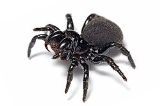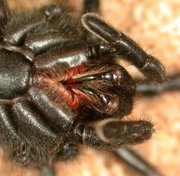
Mygalomorphae
Encyclopedia
The Mygalomorphae, are an infraorder of spider
s. The latter name comes from the orientation of the fangs which point straight down and do not cross each other (as opposed to araneomorph
).
s as well as the dangerous Australasian funnel-web spider
s.
Like the "primitive
" Mesothelae
, they have two pairs of book lungs, and downward pointing chelicerae
. Because of this, the two groups were once believed to be closely related. Later it was realized that the common ancestors of all spiders had these features (Symplesiomorphy
), and that the mygalomorphs just retained them, while the closely related araneomorphs evolved new features (including a cribellum
) (Coddington & Levy, 1991).
Almost all species of Mygalomorphae have eight eyes, however there are some with fewer (Masteria
lewisi has only six eyes).
 They have ample venom
They have ample venom
glands that lie entirely within their chelicerae
, but only spiders of the Australian genus Atrax can be really harmful to humans. Their chelicerae and fangs are large and powerful. Occasionally members of this suborder will even kill small fish
, small mammal
s, and the like.
While the world's biggest spiders are mygalomorphs - Theraphosa blondi (Latreille, 1804) has a body length of 10 cm, and a leg span of 28 cm - some species are less than one millimeter long. Mygalomorphs are capable of spinning at least slightly adhesive silk, and some build elaborate capture webs that approach a meter in diameter (Coddington & Levy, 1991).
Unlike Araneomorphae
, which die after about a year, Mygalomorphae can live for up to 25 years, and some don't reach maturity until they are about six years old. Some flies in the family Acroceridae
which are endoparasites of mygalomorphs may remain dormant in the book lungs for as long as 20 years before beginning their development and consuming the spider.
 Megarachne servinei was thought to be a giant mygalomorph from the Upper Carboniferous (ca. 350 million years ago), but was later found to be an eurypterid
Megarachne servinei was thought to be a giant mygalomorph from the Upper Carboniferous (ca. 350 million years ago), but was later found to be an eurypterid
(Selden et al., 2005a). Thus, the oldest known mygalomorph is Rosamygale grauvogeli Selden & Gall, 1992 (Hexathelidae
) from the Triassic
of north-east France. No mygalomorphs from the Jurassic
have yet been found. (Selden et al., 2005b).
and subtropics
, but their range can extend farther north, e.g. into the southern and western regions of the United States
.
Only few species occur in Europe
. These are of the families Atypidae, Nemesiidae
, Ctenizidae, Hexathelidae
, Theraphosidae and Cyrtaucheniidae, together with only a dozen species.
However, it is suggested that the Mygalomorphae were distributed world-wide before the breakup of Pangaea
(Selden et al., 2005b).
Cladogram of the group
Spider
Spiders are air-breathing arthropods that have eight legs, and chelicerae with fangs that inject venom. They are the largest order of arachnids and rank seventh in total species diversity among all other groups of organisms...
s. The latter name comes from the orientation of the fangs which point straight down and do not cross each other (as opposed to araneomorph
Araneomorphae
The Araneomorphae are a suborder of spiders. They are distinguished by having fangs that oppose each other and cross in a pinching action, in contrast to the Mygalomorphae , which have fangs that are nearly parallel in alignment.- Distinguishing characteristics :Note the difference in the...
).
Description
This grouping of several families includes the heavy bodied, stout legged spiders popularly known as tarantulaTarantula
Tarantulas comprise a group of often hairy and often very large arachnids belonging to the family Theraphosidae, of which approximately 900 species have been identified. Some members of the same Suborder may also be called "tarantulas" in the common parlance. This article will restrict itself to...
s as well as the dangerous Australasian funnel-web spider
Australasian funnel-web spider
Australian funnel-web spiders are venomous spiders of the family Hexathelidae, represented by 31 described species of Hadronyche, four Bymainiella spp., two Teranodes and monotyptic genera Plesiothera fentoni and Ilawarra whisharti...
s.
Like the "primitive
Primitive (biology)
Primitive in the sense most relevant to phylogenetics means resembling the first living things and in particular resembling them in the simple nature of their anatomy and behaviour...
" Mesothelae
Mesothelae
The Mesothelae are a suborder of spiders that includes the extinct families Arthrolycosidae and Arthromygalidae and the only extant family Liphistiidae....
, they have two pairs of book lungs, and downward pointing chelicerae
Chelicerae
The chelicerae are mouthparts of the Chelicerata, an arthropod subphylum that includes arachnids, Merostomata , and Pycnogonida . Chelicerae are pointed appendages which are used to grasp food, and are found in place of the chewing mandibles most other arthropods have...
. Because of this, the two groups were once believed to be closely related. Later it was realized that the common ancestors of all spiders had these features (Symplesiomorphy
Symplesiomorphy
In cladistics, a symplesiomorphy or symplesiomorphic character is a trait which is shared between two or more taxa, but which is also shared with other taxa which have an earlier last common ancestor with the taxa under consideration...
), and that the mygalomorphs just retained them, while the closely related araneomorphs evolved new features (including a cribellum
Cribellum
The cribellum is a silk spinning organ found in certain spiders. Unlike normal spinnerets, the cribellum consists of one or more plates covered in thousands of tiny spigots. These spigots produce extremely fine fibers which are combed out by the spider's calamistrum, producing silk with a wooly...
) (Coddington & Levy, 1991).
Almost all species of Mygalomorphae have eight eyes, however there are some with fewer (Masteria
Masteria
Masteria is a genus of mygalomorph spiders that occurs in the tropics of Central to South America, Asia and Micronesia, with one species found in Australia. It was formerly known as genus Accola....
lewisi has only six eyes).

Venom
Venom is the general term referring to any variety of toxins used by certain types of animals that inject it into their victims by the means of a bite or a sting...
glands that lie entirely within their chelicerae
Chelicerae
The chelicerae are mouthparts of the Chelicerata, an arthropod subphylum that includes arachnids, Merostomata , and Pycnogonida . Chelicerae are pointed appendages which are used to grasp food, and are found in place of the chewing mandibles most other arthropods have...
, but only spiders of the Australian genus Atrax can be really harmful to humans. Their chelicerae and fangs are large and powerful. Occasionally members of this suborder will even kill small fish
Fish
Fish are a paraphyletic group of organisms that consist of all gill-bearing aquatic vertebrate animals that lack limbs with digits. Included in this definition are the living hagfish, lampreys, and cartilaginous and bony fish, as well as various extinct related groups...
, small mammal
Mammal
Mammals are members of a class of air-breathing vertebrate animals characterised by the possession of endothermy, hair, three middle ear bones, and mammary glands functional in mothers with young...
s, and the like.
While the world's biggest spiders are mygalomorphs - Theraphosa blondi (Latreille, 1804) has a body length of 10 cm, and a leg span of 28 cm - some species are less than one millimeter long. Mygalomorphs are capable of spinning at least slightly adhesive silk, and some build elaborate capture webs that approach a meter in diameter (Coddington & Levy, 1991).
Unlike Araneomorphae
Araneomorphae
The Araneomorphae are a suborder of spiders. They are distinguished by having fangs that oppose each other and cross in a pinching action, in contrast to the Mygalomorphae , which have fangs that are nearly parallel in alignment.- Distinguishing characteristics :Note the difference in the...
, which die after about a year, Mygalomorphae can live for up to 25 years, and some don't reach maturity until they are about six years old. Some flies in the family Acroceridae
Acroceridae
Acroceridae is a small family of odd looking flies most closely related to Nemestrinidae. There are about 520 species in 50 genera. They are characterized by a humpbacked appearance and a small head, sometimes with a long proboscis for nectar. As such, acrocerids are commonly known as small-headed...
which are endoparasites of mygalomorphs may remain dormant in the book lungs for as long as 20 years before beginning their development and consuming the spider.
Evolution

Eurypterid
Eurypterids are an extinct group of arthropods related to arachnids which include the largest known arthropods that ever lived. They are members of the extinct order Eurypterida ; which is the most diverse Paleozoic chelicerate order in terms of species...
(Selden et al., 2005a). Thus, the oldest known mygalomorph is Rosamygale grauvogeli Selden & Gall, 1992 (Hexathelidae
Hexathelidae
The spider family Hexathelidae, the only family in the super-family Hexatheloidea, is one of two families of spiders known as funnel-webs...
) from the Triassic
Triassic
The Triassic is a geologic period and system that extends from about 250 to 200 Mya . As the first period of the Mesozoic Era, the Triassic follows the Permian and is followed by the Jurassic. Both the start and end of the Triassic are marked by major extinction events...
of north-east France. No mygalomorphs from the Jurassic
Jurassic
The Jurassic is a geologic period and system that extends from about Mya to Mya, that is, from the end of the Triassic to the beginning of the Cretaceous. The Jurassic constitutes the middle period of the Mesozoic era, also known as the age of reptiles. The start of the period is marked by...
have yet been found. (Selden et al., 2005b).
Distribution
Most members of this infraorder occur in the tropicsTropics
The tropics is a region of the Earth surrounding the Equator. It is limited in latitude by the Tropic of Cancer in the northern hemisphere at approximately N and the Tropic of Capricorn in the southern hemisphere at S; these latitudes correspond to the axial tilt of the Earth...
and subtropics
Subtropics
The subtropics are the geographical and climatical zone of the Earth immediately north and south of the tropical zone, which is bounded by the Tropic of Cancer and the Tropic of Capricorn, at latitudes 23.5°N and 23.5°S...
, but their range can extend farther north, e.g. into the southern and western regions of the United States
United States
The United States of America is a federal constitutional republic comprising fifty states and a federal district...
.
Only few species occur in Europe
Europe
Europe is, by convention, one of the world's seven continents. Comprising the westernmost peninsula of Eurasia, Europe is generally 'divided' from Asia to its east by the watershed divides of the Ural and Caucasus Mountains, the Ural River, the Caspian and Black Seas, and the waterways connecting...
. These are of the families Atypidae, Nemesiidae
Nemesiidae
The Nemesiidae are a spider family of the infraorder Mygalomorphae, and the only member of the superfamily Nemesioidea. They were formerly considered part of the Dipluridae family.-Description:...
, Ctenizidae, Hexathelidae
Hexathelidae
The spider family Hexathelidae, the only family in the super-family Hexatheloidea, is one of two families of spiders known as funnel-webs...
, Theraphosidae and Cyrtaucheniidae, together with only a dozen species.
However, it is suggested that the Mygalomorphae were distributed world-wide before the breakup of Pangaea
Pangaea
Pangaea, Pangæa, or Pangea is hypothesized as a supercontinent that existed during the Paleozoic and Mesozoic eras about 250 million years ago, before the component continents were separated into their current configuration....
(Selden et al., 2005b).
Cladogram of the group

